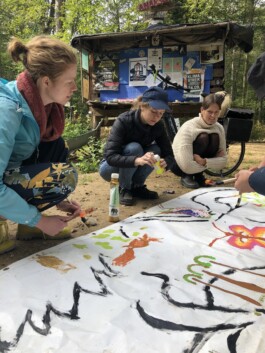
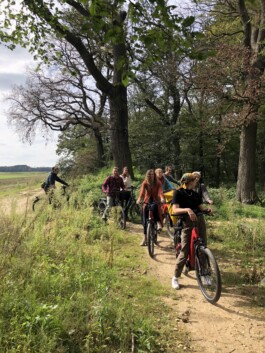
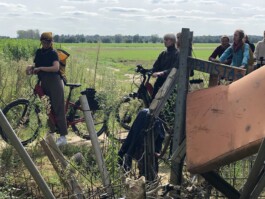
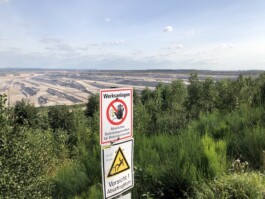
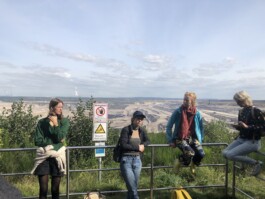
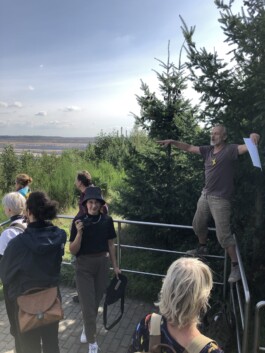
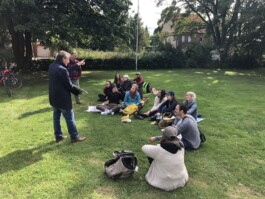
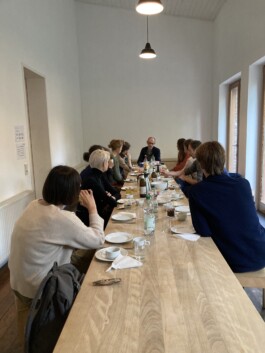
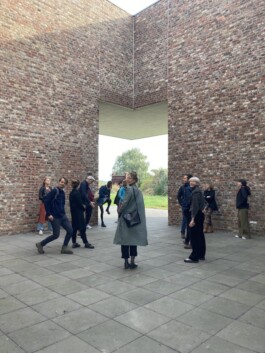
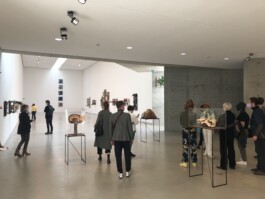
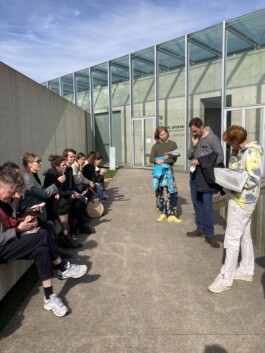
Field Trip
21-22 September
Tagebau Hambach &
Raketenstation Hombroich
The first Borderland Residencies field trip led to a seemingly bottomless pit, a politicised forest and a former military basis turned hideout and playground for artists: A recount of an eventful two days.
The Borderlands are an area of transition. They have seen numerous changes of sovereigns, have been home to people from all over the world and have always been formed by the natural rhythm of the rivers Rhine and Meuse. The people who lived between the two river deltas have continuously shaped the land they inhabited. On September 21st and 22nd, the Borderlanders set out to explore that “land of transformation”.
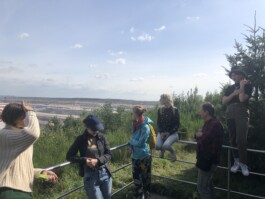
On the sunny, but already autumn-crisp morning of September 21st, the Borderland fellowship holders met at the train station of Kerpen-Buir. Equipped with E-Bikes, they started off into the area of the Hambach Tagebau, the biggest brown coal open pit mining in Rheinisches Braunkohlerevier. Guided by Todde Kemmerich, artist and climate activist, they explored a landscape that has been shaped by industrial mining for over 150 years. A talk with Georg Gelhausen, mayor of the city of Merzenich, introduced the Borderlanders to the complexity of the situation and the reality of living in an area that was (or, in some cases: still is) supposed to be demolished for private profit and public energy supply. An encounter with the climate activists living in the highly controversial forest of Hambach left them with lasting impressions of different approaches to how humans live and interact with nature.
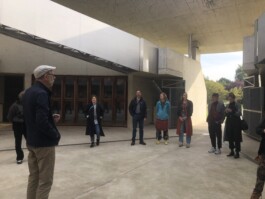
After having finished the tour, everybody regrouped at Raketenstation Hombroich in Neuss. In the calming atmosphere of the guesthouse “Kloster”, they enjoyed dinner and a quiet evening to think back on the day. After having been to an already unusual landscape the day before, Raketenstation Hombroich was another addition to the list of encounters with extraordinary spaces and turbulent pasts.
The next day, tours guided by artist Hans-Willi Notthoff and Mara Sporn, curator at Langen Foundaion, gave insights on the history and uniqueness of Raketenstation Hombroich.
But of course, being in Neuss, the field trip could not end without a visit to the studio of Sanne Vaassen, the local Borderland Resident in Neuss. In her work, she analyses and deconstructs the flowing transitions of our surroundings and questions their symbolism. In Neuss, she has already started her artistic research on colour schemes obtained from botanical samples, on historic seeds and on local soil samples from archaeological excavations.
The Borderlands of the Rhine-Meuse delta are, and have always been, an area of transition and transformation. Some of them are still about to take place – as, for example, the inevitable transformation of the Rheinisches Braunkohlerevier after the successive end of brown coal mining in the next decades. Others have already created unique spaces in which art could unfold in the most unexpected ways, like in the Kulturraum Hombroich.
As true Borderlanders, we are looking forward to the new paths the Borderlands are sure to make!











Field Trip
21-22 September
Tagebau Hambach &
Raketenstation Hombroich
The first Borderland Residencies field trip led to a seemingly bottomless pit, a politicised forest and a former military basis turned hideout and playground for artists: A recount of an eventful two days.
The Borderlands are an area of transition. They have seen numerous changes of sovereigns, have been home to people from all over the world and have always been formed by the natural rhythm of the rivers Rhine and Meuse. The people who lived between the two river deltas have continuously shaped the land they inhabited. On September 21st and 22nd, the Borderlanders set out to explore that “land of transformation”.

On the sunny, but already autumn-crisp morning of September 21st, the Borderland fellowship holders met at the train station of Kerpen-Buir. Equipped with E-Bikes, they started off into the area of the Hambach Tagebau, the biggest brown coal open pit mining in Rheinisches Braunkohlerevier. Guided by Todde Kemmerich, artist and climate activist, they explored a landscape that has been shaped by industrial mining for over 150 years. A talk with Georg Gelhausen, mayor of the city of Merzenich, introduced the Borderlanders to the complexity of the situation and the reality of living in an area that was (or, in some cases: still is) supposed to be demolished for private profit and public energy supply. An encounter with the climate activists living in the highly controversial forest of Hambach left them with lasting impressions of different approaches to how humans live and interact with nature.

After having finished the tour, everybody regrouped at Raketenstation Hombroich in Neuss. In the calming atmosphere of the guesthouse “Kloster”, they enjoyed dinner and a quiet evening to think back on the day. After having been to an already unusual landscape the day before, Raketenstation Hombroich was another addition to the list of encounters with extraordinary spaces and turbulent pasts.
The next day, tours guided by artist Hans-Willi Notthoff and Mara Sporn, curator at Langen Foundaion, gave insights on the history and uniqueness of Raketenstation Hombroich.